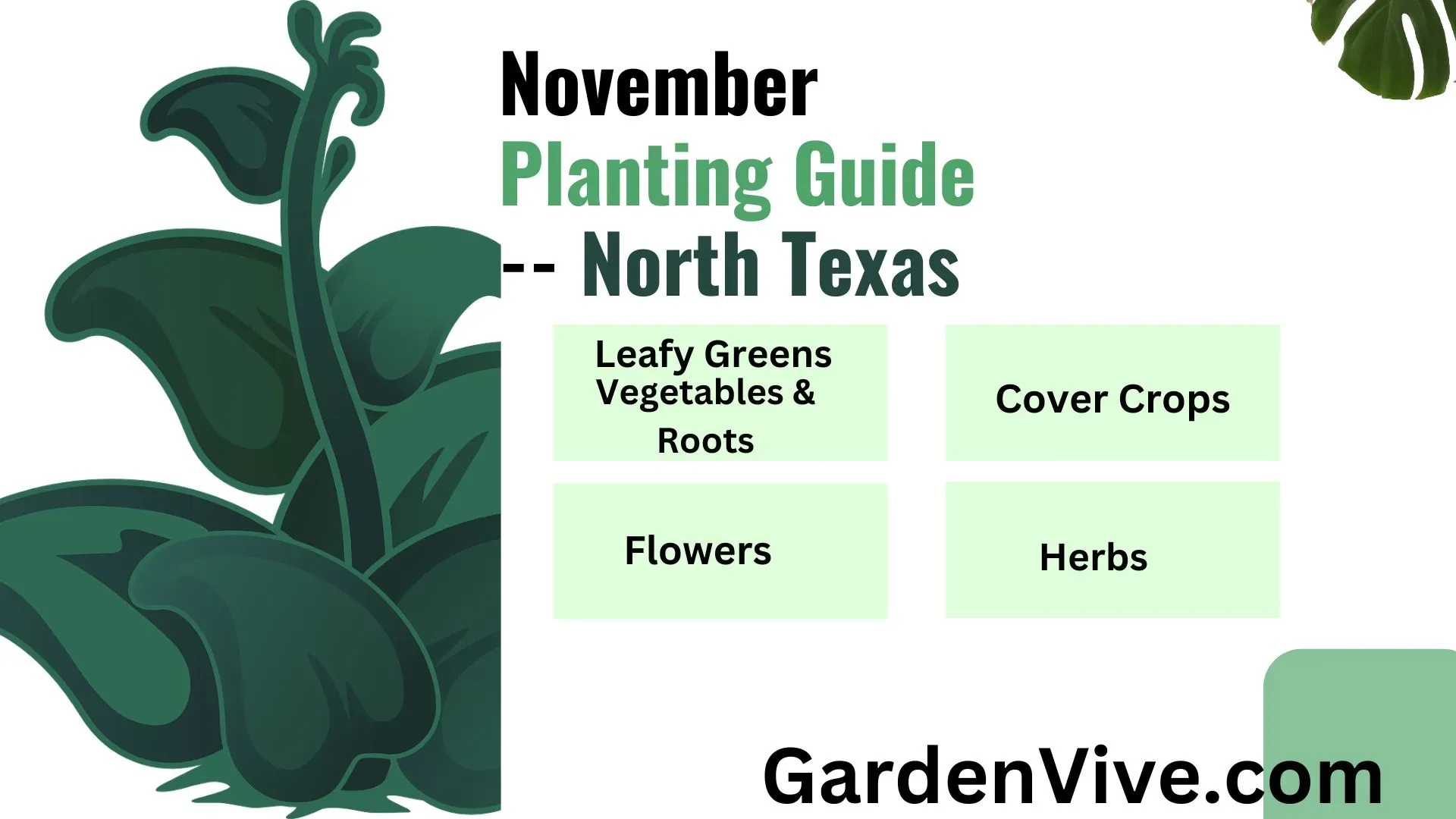
A lot of gardeners assume November is a time to wind down in the garden but North Texas is an exception. The temperature starts to dip and you can observe a mild winter climate. I publish the planting calendar of each month just before the beginning of the month so that you can get enough time to prepare/collect seeds and plan your garden accordingly. In this article, I will only include those plants you can start planting in November either from direct seed sowing or transplanting in North Texas.
If you want to get the full-year planting calendar don't forget to check: North Texas Planting Calendar - Total Guide
If you are a subscriber or a regular reader you know how I structure a planting schedule. I am separating types of plants into categories. This will help you look through the calendar easily and save you time.
- Leafy greens
- Vegetable and roots
- Flowering plants
- Herbs
- Cover crops
Scroll the table sidewise on mobile devices to make sure you don't miss any information.
Leafy greens to plant in November in North Texas
I am only adding those to my list that can perform the best if planted in November.
| Plant Name | Sowing Method | Harvesting Time | Max Height |
|---|---|---|---|
| Spinach | Direct Sow | 40-50 days | 12 inches |
| Kale | Direct Sow or Transplant | 50-70 days | 18-24 inches |
| Swiss Chard | Direct Sow | 50-60 days | 18-24 inches |
| Lettuce | Direct Sow or Transplant | 30-45 days | 6-12 inches |
| Arugula | Direct Sow | 20-30 days | 12 inches |
| Collard Greens | Direct Sow or Transplant | 55-75 days | 24-36 inches |
| Mustard Greens | Direct Sow | 30-40 days | 12-18 inches |
| Bok Choy | Direct Sow or Transplant | 30-45 days | 12-18 inches |
| Endive | Direct Sow | 50-60 days | 6-12 inches |
| Romaine Lettuce | Direct Sow or Transplant | 60-80 days | 8-12 inches |
For Lettuce opt for romaine or butterhead. These varieties can perform best in the chilly winter nights.
Kale and Collards can also perform better as temperature dips. If you like to consume salads more often, don't forget to plant spinach.
Vegetables and Roots to Plant in November in North Texas
In this category, I am only adding vegetables and roots, not the leafy greens I included in my previous table.
If possible check my variety suggestion from this table. The mentioned varieties can perform the best if planted in November.
| Plant Name | Sowing Method | Harvesting Time | Max Height | Variety Suggestion |
|---|---|---|---|---|
| Carrots | Direct Sow | 70-80 days | 12-15 inches | Nantes, Danvers |
| Radishes | Direct Sow | 25-30 days | 6-8 inches | Cherry Belle, French Breakfast |
| Turnips | Direct Sow | 40-60 days | 12-18 inches | Purple Top, White Globe |
| Beets | Direct Sow | 50-60 days | 12 inches | Detroit Dark Red, Golden |
| Garlic | Direct Sow (Cloves) | 180-210 days | 18-24 inches | California Softneck, German White |
| Onions | Transplant | 100-120 days | 24 inches | Yellow Granex, Texas Early White |
| Broccoli | Transplant | 55-65 days | 18-24 inches | Calabrese, Waltham 29 |
| Cauliflower | Transplant | 60-75 days | 18-24 inches | Snowball, Early White |
| Brussels Sprouts | Transplant | 90-100 days | 24-36 inches | Jade Cross, Long Island Improved |
| Parsnips | Direct Sow | 100-120 days | 12-18 inches | Hollow Crown, Harris Model |
I know sometimes it is hard to find the exact variety we are looking for. If you can't find it, go with the local regular variety you are getting.
The harvesting time I mentioned is the normal harvesting time people usually harvest. Most of the plants can be harvested before that and it is totally your preference on eating habit. For example, I prefer to harvest Radishes within weeks. ( As I love to eat the leaves )
If you want to plant one vegetable alongside another plant (companion planting) check my guide on companion planting for vegetable garden.
Flowering Plants
I am considering only winter annual flowering plants here.
| Plant Name | Sowing Method | Blooming Time | Max Height | Variety Suggestion |
|---|---|---|---|---|
| Pansy | Transplant | Late Fall to Early Spring | 6-9 inches | Delta, Matrix |
| Snapdragon | Transplant | Winter to Spring | 12-36 inches | Rocket, Montego |
| Viola | Transplant | Late Fall to Early Spring | 6-8 inches | Sorbet, Penny |
| Stock | Transplant | Winter to Early Spring | 12-18 inches | Cinderella, Katz |
| Dianthus | Transplant | Late Winter to Spring | 6-12 inches | Amazon, Ideal |
| Alyssum | Direct Sow or Transplant | Winter to Early Spring | 4-6 inches | Snow Crystals, Carpet of Snow |
| Calendula | Direct Sow or Transplant | Late Fall to Spring | 12-24 inches | Pacific Beauty, Resina |
| Sweet Pea | Direct Sow | Late Winter to Spring | 6-8 feet (with support) | Mammoth, Old Spice |
| Ornamental Cabbage | Transplant | Late Fall to Winter | 12-18 inches | Osaka, Nagoya |
| English Daisy | Transplant | Late Winter to Early Spring | 6-12 inches | Tasso, Bellissima |
Snapdragon blooms from winter through spring and it will brighten your garden bed.
Calendula is one of my favorites and I have made a guide on growing and caring for calendula, if you are interested read it. This is also known as pot marigold.
Violas will survive and bloom even in extreme cold. The flowers might be smaller but they will bring color to your home garden.
If you are an indoor grower, check: what flowering plants will bloom indoors in North Texas
Herbs to plant in November - North Texas
Most of us prefer to plant veggies and flowers and the most underrated are herbs as per the statistics. Try to add 2 to 3 herbs in your home garden. Believe me, you will fall in love with the herbs.
| Herb Name | Sowing Method | Harvesting Time | Max Height | Variety Suggestion |
|---|---|---|---|---|
| Parsley | Direct Sow or Transplant | 70-90 days | 12-18 inches | Italian Flat Leaf, Moss Curled |
| Thyme | Direct Sow or Transplant | 90-120 days | 6-12 inches | English, Lemon |
| Sage | Transplant | 75-85 days | 18-24 inches | Garden, Pineapple |
| Chives | Direct Sow or Transplant | 60-75 days | 12-15 inches | Common, Garlic |
| Cilantro | Direct Sow | 45-70 days | 12-24 inches | Santo, Calypso |
| Oregano | Transplant | 80-90 days | 12-24 inches | Greek, Italian |
| Mint | Transplant | 60-70 days | 18-24 inches | Peppermint, Spearmint |
| Dill | Direct Sow | 40-60 days | 24-36 inches | Bouquet, Fernleaf |
| Fennel | Direct Sow | 80-100 days | 24-48 inches | Florence, Bronze |
| Chervil | Direct Sow | 60-90 days | 12-18 inches | Plain, Curled |
Cover crops to plant in November in North Texas
| Cover Crop Name | Sowing Method | Growth Period | Max Height | Variety Suggestion | Fertilizer |
|---|---|---|---|---|---|
| Winter Rye | Direct Sow | Winter to Spring | 24-36 inches | Aroostook, Wrens Abruzzi | Low nitrogen needed; use compost before planting |
| Hairy Vetch | Direct Sow | Winter to Spring | 12-24 inches | Common Vetch, Purple Bounty | Low nitrogen needed; add phosphorus for root growth |
| Austrian Winter Peas | Direct Sow | Winter to Spring | 12-18 inches | FrostMaster, Blaze | Low nitrogen needed; phosphorus may enhance blooming |
| Crimson Clover | Direct Sow | Late Winter to Spring | 12-24 inches | Dixie, Kentucky Pride | Phosphorus before planting; minimal nitrogen |
| Oats | Direct Sow | Winter to Early Spring | 24-36 inches | Jerry, Cayuse | Compost for balanced nutrients; low nitrogen needs |
| Barley | Direct Sow | Winter to Spring | 24-36 inches | Pearl, Steptoe | Balanced compost; add potassium if soil is poor |
| Annual Ryegrass | Direct Sow | Fall to Spring | 6-12 inches | Gulf, Tetraploid | Compost for healthy growth; low nitrogen |
| Mustard Greens | Direct Sow | Fall to Winter | 12-18 inches | Florida Broadleaf, Red Giant | Low nitrogen; add phosphorus for root health |
| Radish (Daikon) | Direct Sow | Winter to Early Spring | 12-24 inches | Daikon, Minowase | Compost; minimal nitrogen, add potassium if needed |
| Field Peas | Direct Sow | Fall to Spring | 18-30 inches | Whistler, Pisum | Low nitrogen needed; phosphorus to support blooms |
If you find this article helpful consider sharing it with your friends who love to do gardening in North Texas.



